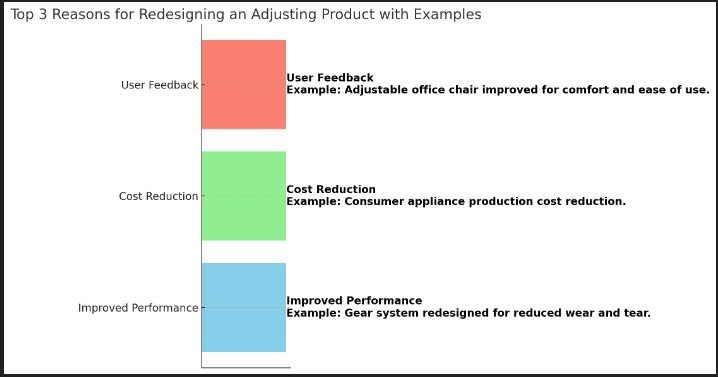Redesigning and adjusting a product is crucial for improving overall design quality and functionality. Here are the top three reasons:

1. 𝐈𝐦𝐩𝐫𝐨𝐯𝐞𝐝 𝐏𝐞𝐫𝐟𝐨𝐫𝐦𝐚𝐧𝐜𝐞
Explanation:
Objective: Enhance the product’s functionality, reliability, or efficiency.
Mechanical Design Perspective: As an engineer, you may be tasked with optimizing the mechanical components to achieve better performance. This could involve re-evaluating load-bearing elements, minimizing friction, or improving thermal management. Advanced simulation tools, such as FEA (Finite Element Analysis) and CFD (Computational Fluid Dynamics), are often used to predict and enhance performance.
Example:
Case: A gear system in a piece of machinery is redesigned to reduce wear and tear.
Action: You might select higher-grade materials, refine gear teeth profiles, or incorporate better lubrication methods to enhance durability and efficiency.
2. 𝐂𝐨𝐬𝐭 𝐑𝐞𝐝𝐮𝐜𝐭𝐢𝐨𝐧
Explanation:
Objective: Lower production costs while maintaining or improving quality.
Mechanical Design Perspective: Reducing costs often involves design simplifications, material substitutions, or process improvements. As an engineer, you may explore design for manufacturability (DFM) principles, which aim to simplify the manufacturing process, reduce part counts, and improve ease of assembly.
Example:
Case: A consumer appliance needs to be produced at a lower cost to remain competitive.
Action: You might redesign components to use less expensive materials, simplify the assembly process, or integrate multiple functions into a single part to reduce manufacturing steps and costs.
3. 𝐔𝐬𝐞𝐫 𝐅𝐞𝐞𝐝𝐛𝐚𝐜𝐤
Explanation:
Objective: Address user concerns and improve the user experience.
Mechanical Design Perspective: User feedback can reveal issues with ergonomics, usability, or reliability that were not apparent during the initial design phase. As an engineer, you might need to adjust the design to improve these aspects, ensuring that the product is more intuitive, comfortable, and reliable for users.
Example:
Case: Users report that an adjustable office chair is difficult to operate and uncomfortable over long periods of time.
Action: You might redesign the adjustment mechanisms to be more intuitive and robust, improve the seat cushioning, and refine the ergonomic design to provide better support and comfort.